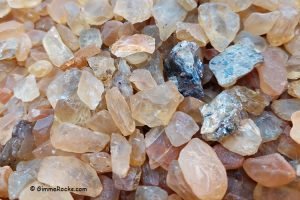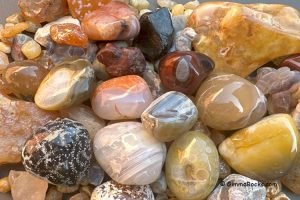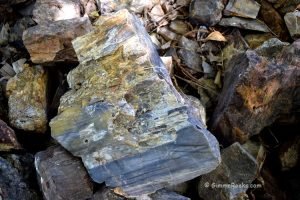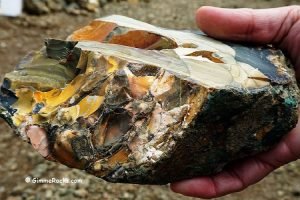Collecting beautiful rocks along the shore is one of the most relaxing and rewarding hobbies. If you've ever walked along the beach and picked up a shiny rock or shell, you're pretty much rockhounding already. You just need to know where to look and what to look for.
Why is ocean beachcombing the most rewarding experience? The answer is simple. The mighty ocean waves crash onto the beaches, constantly delivering new treasures right at your feet. The power of the waves acts like a natural lapidary, tumbling and polishing stones over time.
Some of the best places to find cool rocks and minerals in the United States are along the Pacific Coast and the shores of the Great Lakes. Some beaches on the East Coast are also great rockhounding spots.
Best Ocean Beachcombing and Rock Collecting Spots
Pacific Coast
Some of the top agate and jasper beaches in the U.S. are located along the Pacific Coast in California, Oregon, and Washington.
There are numerous well-known spots in California to hunt for agates and other treasures, with the best ones including Patrick's Point Beach, Agate Beach, Jade Cove, and Palos Verdes.
Washington also has great beaches to collect ocean treasures, including Damon Point, Westport Beach, and Olympic Peninsula Beaches (Ruby Beach and Rialto Beach).
However, the best coastline rockhounding location is Oregon for its unique combination of geology, diverse coastal formations, and abundant collectible rocks, minerals, and fossils.
Some of the best Oregon beachcombing and rockhounding spots include:
- North Coast: Short Beach and Tunnel Beach.
- Central Coast: Gleneden Beach, Beverly Beach, Moolack Beach, and Bob Creek Beach.
- South Coast: McVay Rock Park, Crissey Field State Recreation Site, Bailey Beach, and Pistol River State Scenic Viewpoint.

Atlantic Coast
The Atlantic Coast has its own set of unique collectibles, including fossils (especially shark teeth) and various interesting rocks.
You can search for agate, jasper, and quartz on Plymouth Beach in Massachusetts, "Cape May diamonds" (quartz pebbles polished by the ocean), and fossils at Cape May in New Jersey.
You can find fossils, especially shark teeth, on North and South Carolina, Maryland, and Florida beaches.
Worldwide
The beaches of Canada, New Zealand, Iceland, and Scotland are all known for their unique geological treasures.
The Baltic Sea is also remarkable for the amber. Some spots in Poland, Lithuania, Latvia, and Russia are nature's treasure chests of that mineral.

Ocean Beachcombing Tips: How to Find the Largest and Best Rocks
Research the Location: Do online research: websites like nwrockhounding.com and oregondiscovery.com are great resources to look for regional information. Join mineral clubs and rockhounding Facebook groups.
Know the Local Geology: Some beaches are known for specific minerals, such as quartz, jasper, or agates. Research the local geology to understand the types of minerals in the area.
Look for the Right Beaches: Gravel beaches are the best; the more gravel, the more rocks. Sandy beaches can still have collectible minerals, but you'll need to dig more to find anything good.
Timing is Everything: Low tide after a storm is the best time to find rocks. Ocean storms clear away sand and move rocks around, revealing treasures underneath.
Bring the Right Tools: A small shovel, good boots, and a bucket or bag will help. I also recommend gloves to protect your hands from sharp rocks. Sand dipper beach scoop is also useful for saving your back and making collecting rocks easier.
Where to Find the Best Rocks on the Beach
High Tide Line: This is where the waves deposit materials. It often contains a mix of pebbles, shells, and minerals.
Pebble Beds: Look for areas with gravel or pebble beds, as these often hold various minerals.
A Protected Cove: With great wave action, a cove frequently collects and renews more rocks.
Rocky Outcrops: Examine rocks along the shoreline, especially those weathered by the ocean. You may find veins of minerals within them.
Stream Mouths: Where streams meet the ocean, they often carry minerals downstream, which can get deposited on the beach.

The Most Common Rocks You Can Find On The Beach
Agates: These range from clear, yellow, red, and orange to purple, deep blue, and almost black. Look for their smooth, glassy surface and slight translucence.
Agates tend to sparkle when wet, making them easier to spot. Another trick is to walk with the sun in front of you so that agates shine more than the other rocks.
Jasper and Chert: These stones can be red, yellow, brown, and green. They have a more solid appearance compared to agates and shine when wet.
Petrified Wood: Look for parallel lines or woody textures. Petrified wood is often black, brown, or reddish and can be confused with other rocks like sandstone.
Quartz: Often found as smooth pebbles or small crystals, quartz is one of the most common minerals on beaches. The quartz is often milky white with gray to black banding.

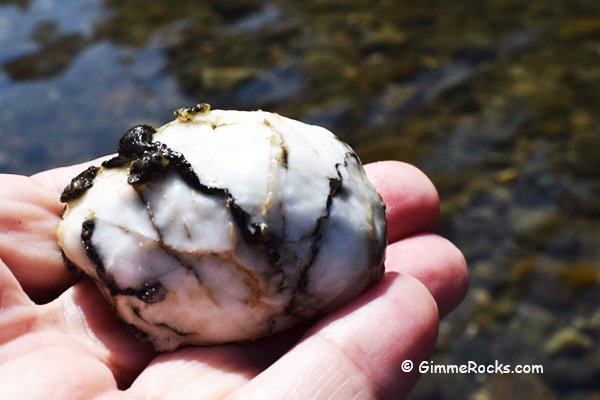
Fossils: While not technically minerals, fossils can often be found along the shore. You can find a shell or tooth. Sometimes, fossil materials are found in concretions or cliffs. However, many beaches have restrictions against digging into cliffs.
Sea Glass: Sea glass, sometimes called 'mermaid tears,' is not a mineral but still a prized find. Once ordinary glass trash — bottles, jars, lenses, and even shipwreck remnants — transforms through years of tumbling in the ocean's waves, sand, and salt.
You can find sea glass on the beaches' shores near areas with higher human activity or sea traffic.

Gneiss and Schist: Both are metamorphic rocks, which means they've been changed by heat and pressure deep in the Earth. Have you ever seen a rock with layers or bands of different colors? That's what gneiss looks like. It has striped patterns that can be light and dark, almost like a zebra! It's usually hard and tough. Sometimes, it even sparkles.
Schist, on the other hand, is a bit different. It's made up of thin layers that can flake off. It often has a shiny, glittery appearance because of minerals like mica. Picture picking up a rock and noticing it shimmers in the sunlight—that's schist!
How to Identify Minerals
When you're on the beach, keep your eyes peeled.
Look for color variations: When you're scanning the beach, search for stones that stand out from the others. Agate and jasper often have a smoother texture and can show a band.
Flip over stones: You might find something special hiding underneath. Sometimes, the best minerals are buried or lying under other rocks.
Walk along the water's edge: This is where the waves deposit new stones. Watch for the translucent glow of agates and shining wet jasper. You can also try standing in shallow water and letting the waves roll the stones past you.
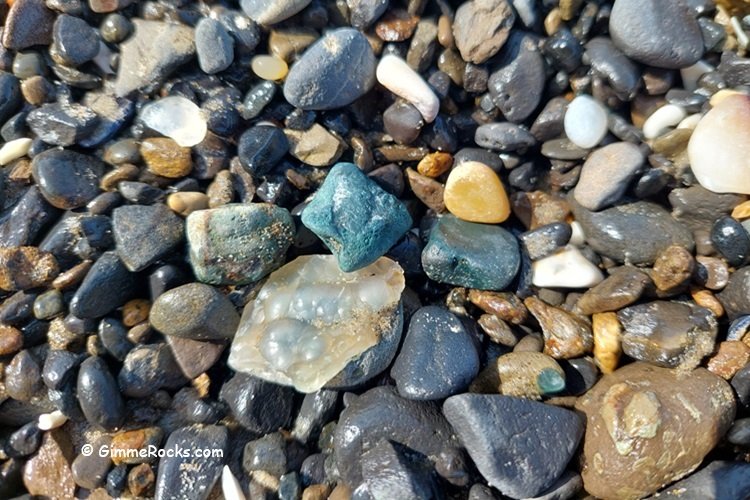
Rockhounding Safety Precautions
Rockhounding is a safe hobby, but the ocean can be unforgiving if you are careless. Here are some things to watch out for:
Sneaker Waves: These waves can come out of nowhere and sweep you off your feet. Always keep an eye on the ocean, especially if you're near the waterline.
Slippery Rocks: Tide pools and wet rocks can be slippery. Wear shoes with good grip, and be careful where you step.
Tides: Don't get caught and stranded by the rising tide. Make sure you know when the tide is coming in so you don't get trapped on a rock or in a cove.
I always check the tide tables before setting out, and I recommend you do the same. A quick check can save you from a dangerous situation.
Rockhounding Regulations: Know What You Can and Can't Collect
Every area has different regulations about what you can collect and how much you can take.
For example, in Oregon, you cannot remove more than one gallon of agates and other non-living items such as shells, fossils, and stones per person per day. The annual limit is three gallons per person.
In contrast, other areas may let you dig a bit deeper, like some Bureau of Land Management (BLM) lands, but be sure to check local rules before you go.

